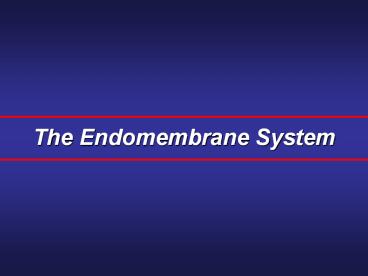The Endomembrane System - PowerPoint PPT Presentation
Title:
The Endomembrane System
Description:
The Endomembrane System A series of membranes found in the interior of a eukaryotic ... Plant vacuoles store water, sugars, salt, pigments, and toxic substances to ... – PowerPoint PPT presentation
Number of Views:705
Avg rating:3.0/5.0
Title: The Endomembrane System
1
The Endomembrane System
2
The Endomembrane System
- A series of membranes found in the interior of a
eukaryotic cell. It divides the cell into
compartments, channels the passage of molecules
through the interior of the cell and provides
surfaces for the synthesis of lipids and some
proteins.
3
The Endomembrane System
- One of the fundamental distinctions between
eukaryotes and prokaryotes.
4
The Endomembrane System
- Nuclear Envelope
- Endoplasmic reticulum (ER)
- Golgi Apparatus
- Vesicles (Vacuoles)
5
Nuclear Envelope
- Double membrane
- Pores permit exit of
- ribosomal subuints
- Separates nucleoplasm from cytoplasm
6
Endoplasmic Reticulum
- System of membrane channels continuous with outer
membrane of the nuclear envelope.
7
(No Transcript)
8
Rough ER is
- Contiguous with the outer membrane of the nuclear
envelope. - Studded with ribosomes on the cytoplasm side.
9
Function of Rough ER
- Protein synthesis and modification.
10
Function of Rough ER
- Protein synthesis and modification.
- Membrane Synthesis
- Distributes Transport Vesicles
11
Destinations of Rough ER Proteins
- Exported from the cell
- Sent to lysosomes or vacuoles
- Embedded in plasma membrane
12
Smooth ER
- Continuous with rough ER
- No ribosomes (hence smooth)
13
Function of smooth ER
- 1. Synthetic processes
- Phospholipids
- Steroids
- Fatty acids
- Forms transport vesicles
- Stores Calcium
- Detoxifies poisons
14
Golgi ApparatusDelivery System Of the Cell
- Discovered in 1898
- Named
- For
- Camillo Golgi
15
Golgi Apparatus
- Stack of 3-20 slightly curved saccules.
- 1 to few (protists)
- 20 or more - animal cells
- Several hundred plant cells
16
Golgi Apparatus
- Receives protein-filled vesicles that bud from
the ER. - Vesicles fuse with membrane of Golgi apparatus
cis face.
17
Golgi Apparatus
- Proteins modified as they pass through (form
glycoproteins) - Move to outer (trans) face after modification.
- Vesicles form move to different locations in
cell. - At plasma membrane, vesicles discharge contents
as secretions.
18
(No Transcript)
19
VesiclesEnzyme Storehouses
- Lysosomes Intracellular digestion centers bud
from endomembrane system - Microbodies
- ? Peroxisomes Enzymes catalyze the removal
of hydrogen atoms. - ? Glyoxysomes Found in plants. Enzymes convert
fats into carbohydrates
20
Lysosomes Intracellular digestion centers
- Produced by Golgi
- Membrane-enclosed vesicles
- Contains digestive enzymes (function best in
acidic environment) - Break down organelles
Animation Lysosome Formation
21
Lysosomes Intracellular digestion centers
- Eliminates cells engulfed by phagocytosis.
- White blood cells use lysosomes to digest
- engulfed bacteria.
- Autodigestion - when lysosomes digest
- parts of cells.
- Apoptosis - programmed cell death, a normal part
of development - Tadpole tail absorption.
- Degeneration of webbing between fingers
22
Peroxisomes
- Abundant in cells that metabolize lipids
- Detoxify alcohol in liver and yeast cells
- Forms hydrogen peroxide that is broken
- down to water and oxygen by catalase.
- RH2 O2 ? R H2O2 ? H2O O2
23
Glyoxysomes(Peroxisomes in plants)
- In leaves carry out reactions the uses up O2 and
releases CO2 that can be used in photosynthesis - In germinating seeds - convert oils into sugars
used as nutrients by growing plants.
24
Vacuoles
- Large membranous sac
- Larger than vesicles
- Store substances
- Vacuoles in protozoans include digestive
vacuoles and water- regulating contractile
vacuoles.
25
Vacuoles
- In protozoans include digestive vacuoles and
water-regulating contractile vacuoles.
26
Vacuoles
- Plant cell vacuoles (usually one or two) more
prominenet water-filled and give support to
cell. - Plant vacuoles store water, sugars, salt,
pigments, and toxic substances to protect plant
from herbivores.
27
(No Transcript)

